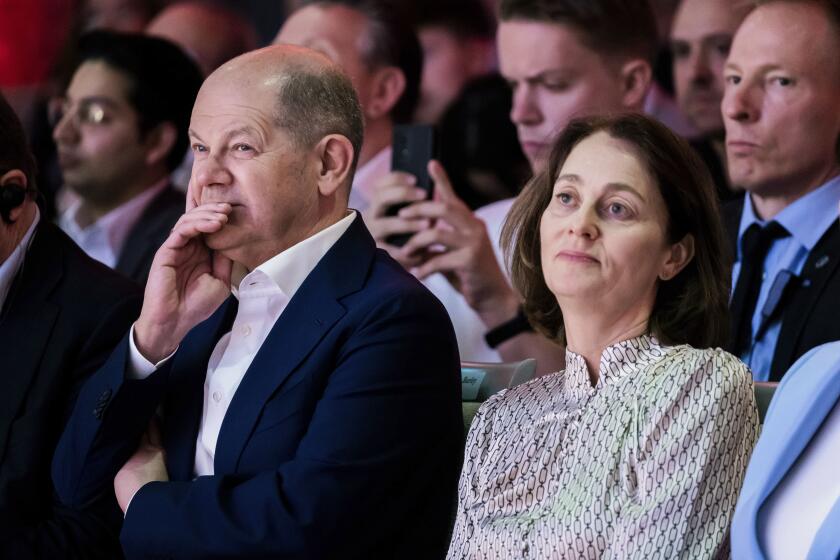Andy Jackson Gets a $20 Makeover
The greenback will still be green, but it will also be pale blue and light peach and yellow -- with a touch of copper.
Federal officials, trying to get a step ahead of high-tech counterfeiters, unveiled the new $20 bill Tuesday. When it is distributed to banks this fall, the $20 will be the first bill in decades to add a few dashes of color to today’s staid green.
A portrait of Andrew Jackson will still be the central feature. But instead of the traditional off-white, the background will be pastel green on the sides and light peach in the center, around Jackson. On the front, a light blue eagle will assume most of the space to Jackson’s left.
The injection of color into the note was not the mere whim of a designer trying to match the colorful money of many foreign countries.
“The purpose of the new design is clear: it’s to stay ahead of anyone who tries to compromise the security and the integrity of the dollar through counterfeiting,” said Treasury Secretary John W. Snow.
Officials chose to change the $20 bill first because it is the most frequently counterfeited within the United States, although the $100 bill is more commonly counterfeited abroad.
The $50 and $100 notes will undergo similar changes over the next few years. Officials are still deciding whether to remake the $5 and $10 bills, but the $1 and $2 bills will stay as they are.
The $20 is the second most-commonly used bill behind the $1.
A variety of devices are being worked into the new $20 bills to thwart counterfeiters, who have become ever more expert at producing convincing fakes. Tiny yellow “20s” float in the reverse side’s background. Depending on the angle you look at it, the large “20” on the face’s lower-right corner can appear copper or green.
In 2002, authorities seized $130 million in fraudulent U.S. notes worldwide before they were circulated and detected $44.3 million in phony U.S. currency after it had passed into unwitting hands. All told, $70 million in counterfeit currency is circulating alongside $620 billion in the genuine article.
Despite the assault by counterfeiters, the amount of fake money circulating has remained fairly constant over recent decades, according to the U.S. Secret Service. Only one or two notes in every 10,000 is fake.
That is a far cry from the Civil War, when one-third of the currency in circulation was counterfeit, according to W. Ralph Basham, director of the Secret Service, which was founded then to fight the problem.
For a long time, counterfeiting was the domain of organized crime, which used traditional printing methods that required skilled printers and costly equipment. But computer technology has made it possible to create counterfeit money from home. Only 1% of counterfeit notes detected in the United States were digitally produced in 1995. But by 2002, nearly 40% were, according to the Secret Service.
Officials said Americans would have to get used to seeing their money change like clothing fashions. In response to the challenge posed by counterfeiters, the government plans to introduce a new design every seven to 10 years. The most recent $20 note -- with the larger portrait and color-shifting ink in the lower right-hand corner of the bill’s front -- was introduced in 1998. By the time that bill hit the streets, the government was already working on its successor.
This year’s version of the $20 will not be the first multicolored bill, collectors said. In 1869, U.S. bills ranging from $1 to $1,000 were printed in a variety of colors. In 1905, the $20 bill had a red Treasury seal as well as some yellow and gold, according to currency experts.
Then as now, the colors were introduced as an anti-counterfeiting measure, said A.M. Kagin, a currency and coin collector.
“The more complicated you make it, the harder it is for counterfeiters to reproduce it,” Kagin said. But those colors were discontinued, he said, because of their cost.
During World War II, notes with the Treasury seal colored gold were printed for the troops invading North Africa, said Stephen Bobbitt, spokesman for the American Numismatic Assn.
The government officials gathered Tuesday hailed the new $20 bill as singer Paul Simon’s “Kodachrome” played and a huge replica of the bill was displayed on stage.
“I think the new note looks absolutely beautiful,” said U.S. Treasurer Rosario Marin.
Tom Ferguson, director of the Treasury’s Bureau of Engraving and Printing, which produces the currency, said the unveiling was “almost as exciting as the birth of a child.”
And Federal Reserve Chairman Alan Greenspan deadpanned: “My only chagrin is that in asking for a free sample, I was rebuffed.”
More to Read
Start your day right
Sign up for Essential California for news, features and recommendations from the L.A. Times and beyond in your inbox six days a week.
You may occasionally receive promotional content from the Los Angeles Times.






